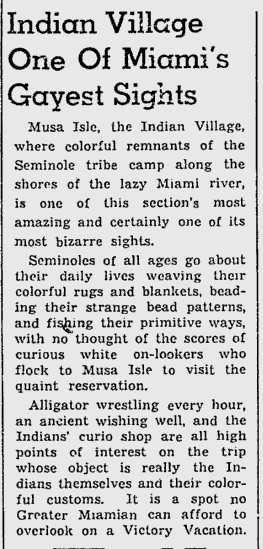 |
| Musa Isle Fruit Farm. (1912) Original caption: Lady Lou entering the mouth of state drainage canal, Miami, Fla. All images via the Library Congress. (Click here to enlarge.) |
The city even had its first tourist trap, a place called Musa Isle, three miles up the Miami River, not far from such present-day monuments as the Metro Justice Center and the Orange Bowl.
A launch, the Sallie, ferried tourists to Musa Isle from the dock at the Royal Palm Hotel. The trip was de rigueur for Royal Palm guests, no less so than a round of golf on the hotel links or a lesson from Percy Cavill, hotel swimming pro.
As the Sallie puttered through the mangroves, tourists craned to glimpse their first alligator. At the Musa Isle gift shop, they bought post cards and guava jelly. There was a three-story observation tower, admission one dime, from which a visitor could gaze westward over "the mysterious Everglades, where only Indians dare go." -Miami Herald, Oct. 8, 1989.
 |
| Detail from above photograph. (Click here to enlarge.) |
 |
| Avenue of Royal Palms, Musa Isle, Miami, Fla. (1912) (Click here to enlarge.) |
 |
| Miami Daily Metropolis, Nov. 26, 1919. |
 |
| Miami Daily Metropolis, Oct. 25, 1921. (Click here to enlarge.) |
 |
| Miami Daily News, Jan. 15, 1929. |
 |
| Miami Daily News, July 31, 1942. |
From the Miami Herald, Oct. 16, 1987...
Miami at the turn of the century was so close to the Everglades that the River of Grass dropped several feet in a fall near Northwest 30th Avenue and 18th Terrace, creating rapids dramatic enough to power a starch mill and attract tourists in sightseeing boats. Earlier, it was a settlement that briefly supported a 1,000-acre riverside plantation until Indians scared off the newcomers. In the 1830s, the mouth of the river became home to the soldiers of Fort Dallas (where the DuPont Plaza Hotel stands today), and by the end of the era several enterprising gentlemen had found lucrative ways to use the river.
Charles Richardson, whose citrus groves upstate were devastated in the freeze of 1895-96, settled on Musa Isle at Northwest South River Drive and 25th Avenue, where he and his son set up a fruit stand. On their outings to the rapids, tourists stopped there to buy produce. Soon riverboats were plying the waters, carrying sightseers to a 60-foot wooden observation tower with a vista of the rapids and the glades beyond and to another attraction on the south bank at Northwest 19th Avenue, Coppinger's Tropical Garden and Indian Village. It was there that Henry Coppinger Jr. practiced the art of alligator wrestling, which he taught to Indians, who carry on the tradition to this day.
 |
| Undated tourist brochure for Musa Isle. The attraction was closed in 1964. |

No comments:
Post a Comment
Feel free to comment on anything you read here.
However, all comments must first be approved.
Please note that spam and spam links will not be tolerated or approved.